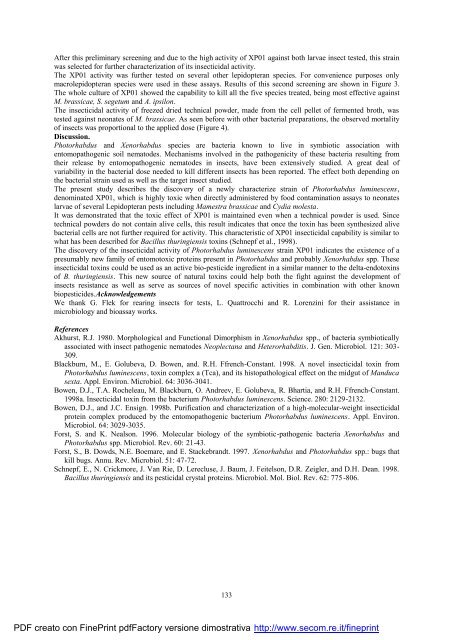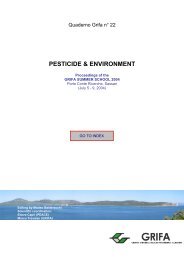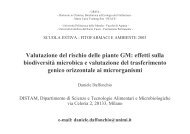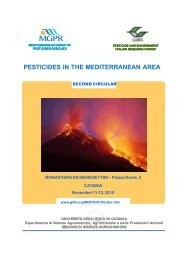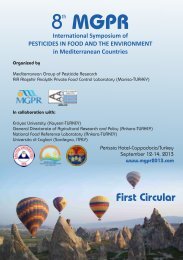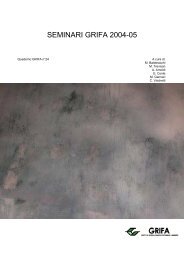International Congress BIOLOGICAL PRODUCTS - Gruppo di ...
International Congress BIOLOGICAL PRODUCTS - Gruppo di ...
International Congress BIOLOGICAL PRODUCTS - Gruppo di ...
Create successful ePaper yourself
Turn your PDF publications into a flip-book with our unique Google optimized e-Paper software.
After this preliminary screening and due to the high activity of XP01 against both larvae insect tested, this strain<br />
was selected for further characterization of its insecticidal activity.<br />
The XP01 activity was further tested on several other lepidopteran species. For convenience purposes only<br />
macrolepidopteran species were used in these assays. Results of this second screening are shown in Figure 3.<br />
The whole culture of XP01 showed the capability to kill all the five species treated, being most effective against<br />
M. brassicae, S. segetum and A. ipsilon.<br />
The insecticidal activity of freezed dried technical powder, made from the cell pellet of fermented broth, was<br />
tested against neonates of M. brassicae. As seen before with other bacterial preparations, the observed mortality<br />
of insects was proportional to the applied dose (Figure 4).<br />
Discussion.<br />
Photorhabdus and Xenorhabdus species are bacteria known to live in symbiotic association with<br />
entomopathogenic soil nematodes. Mechanisms involved in the pathogenicity of these bacteria resulting from<br />
their release by entomopathogenic nematodes in insects, have been extensively stu<strong>di</strong>ed. A great deal of<br />
variability in the bacterial dose needed to kill <strong>di</strong>fferent insects has been reported. The effect both depen<strong>di</strong>ng on<br />
the bacterial strain used as well as the target insect stu<strong>di</strong>ed.<br />
The present study describes the <strong>di</strong>scovery of a newly characterize strain of Photorhabdus luminescens,<br />
denominated XP01, which is highly toxic when <strong>di</strong>rectly administered by food contamination assays to neonates<br />
larvae of several Lepidopteran pests inclu<strong>di</strong>ng Mamestra brassicae and Cy<strong>di</strong>a molesta.<br />
It was demonstrated that the toxic effect of XP01 is maintained even when a technical powder is used. Since<br />
technical powders do not contain alive cells, this result in<strong>di</strong>cates that once the toxin has been synthesized alive<br />
bacterial cells are not further required for activity. This characteristic of XP01 insecticidal capability is similar to<br />
what has been described for Bacillus thuringiensis toxins (Schnepf et al., 1998).<br />
The <strong>di</strong>scovery of the insecticidal activity of Photorhabdus luminescens strain XP01 in<strong>di</strong>cates the existence of a<br />
presumably new family of entomotoxic proteins present in Photorhabdus and probably Xenorhabdus spp. These<br />
insecticidal toxins could be used as an active bio-pesticide ingre<strong>di</strong>ent in a similar manner to the delta-endotoxins<br />
of B. thuringiensis. This new source of natural toxins could help both the fight against the development of<br />
insects resistance as well as serve as sources of novel specific activities in combination with other known<br />
biopesticides.Acknowledgements<br />
We thank G. Flek for rearing insects for tests, L. Quattrocchi and R. Lorenzini for their assistance in<br />
microbiology and bioassay works.<br />
References<br />
Akhurst, R.J. 1980. Morphological and Functional Dimorphism in Xenorhabdus spp., of bacteria symbiotically<br />
associated with insect pathogenic nematodes Neoplectana and Heterorhab<strong>di</strong>tis. J. Gen. Microbiol. 121: 303-<br />
309.<br />
Blackburn, M., E. Golubeva, D. Bowen, and. R.H. Ffrench-Constant. 1998. A novel insecticidal toxin from<br />
Photorhabdus luminescens, toxin complex a (Tca), and its histopathological effect on the midgut of Manduca<br />
sexta. Appl. Environ. Microbiol. 64: 3036-3041.<br />
Bowen, D.J., T.A. Rocheleau, M. Blackburn, O. Andreev, E. Golubeva, R. Bhartia, and R.H. Ffrench-Constant.<br />
1998a. Insecticidal toxin from the bacterium Photorhabdus luminescens. Science. 280: 2129-2132.<br />
Bowen, D.J., and J.C. Ensign. 1998b. Purification and characterization of a high-molecular-weight insecticidal<br />
protein complex produced by the entomopathogenic bacterium Photorhabdus luminescens. Appl. Environ.<br />
Microbiol. 64: 3029-3035.<br />
Forst, S. and K. Nealson. 1996. Molecular biology of the symbiotic-pathogenic bacteria Xenorhabdus and<br />
Photorhabdus spp. Microbiol. Rev. 60: 21-43.<br />
Forst, S., B. Dowds, N.E. Boemare, and E. Stackebrandt. 1997. Xenorhabdus and Photorhabdus spp.: bugs that<br />
kill bugs. Annu. Rev. Microbiol. 51: 47-72.<br />
Schnepf, E., N. Crickmore, J. Van Rie, D. Lerecluse, J. Baum, J. Feitelson, D.R. Zeigler, and D.H. Dean. 1998.<br />
Bacillus thuringiensis and its pesticidal crystal proteins. Microbiol. Mol. Biol. Rev. 62: 775 -806.<br />
PDF creato con FinePrint pdfFactory versione <strong>di</strong>mostrativa http://www.secom.re.it/fineprint<br />
133


